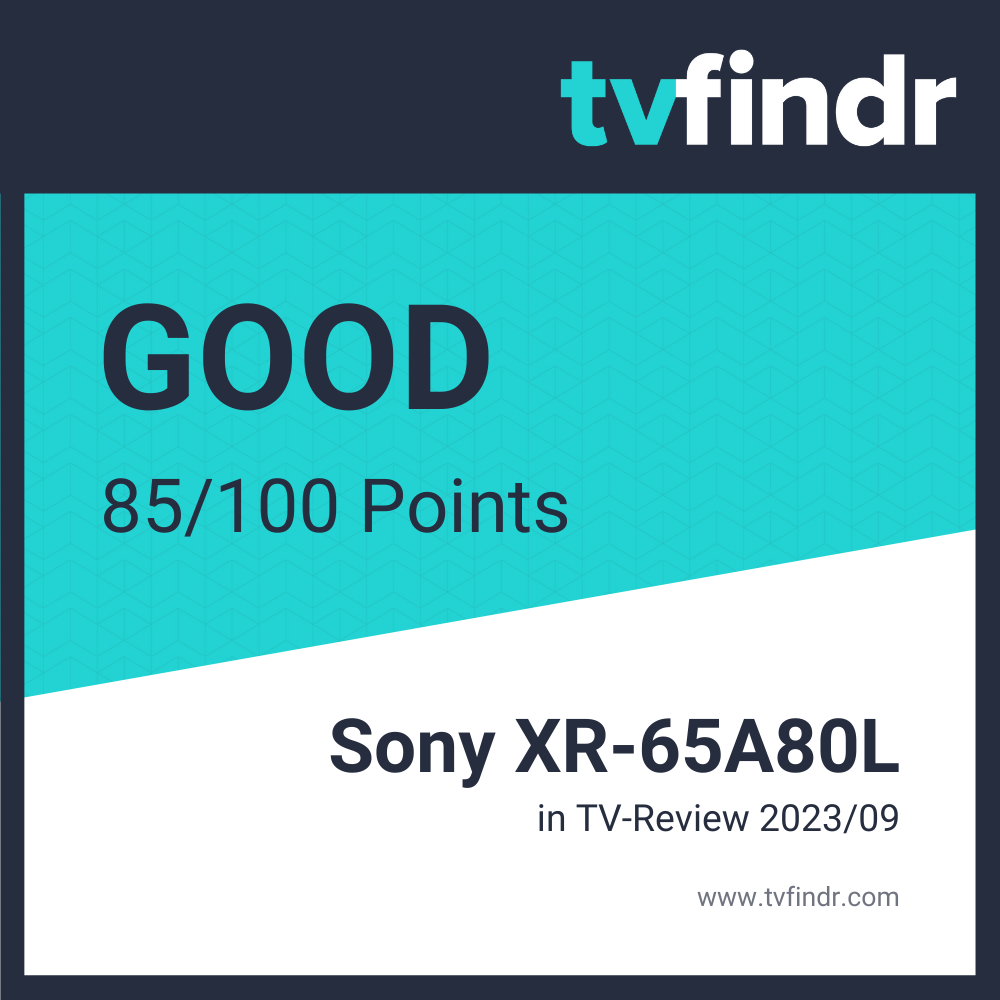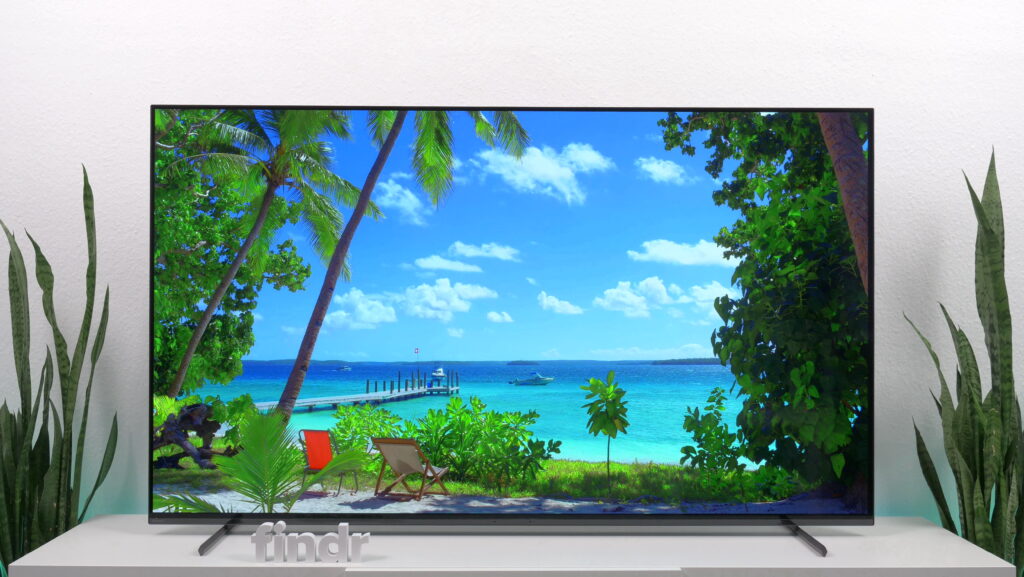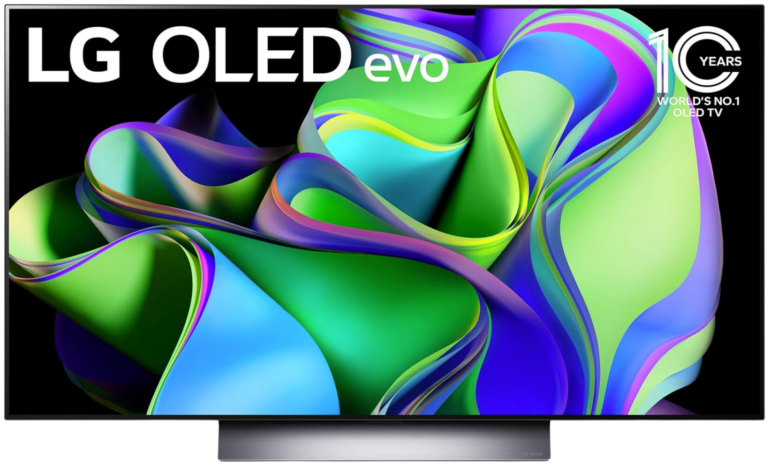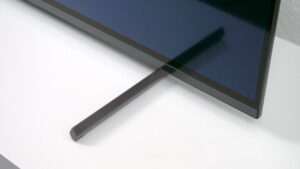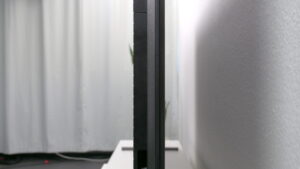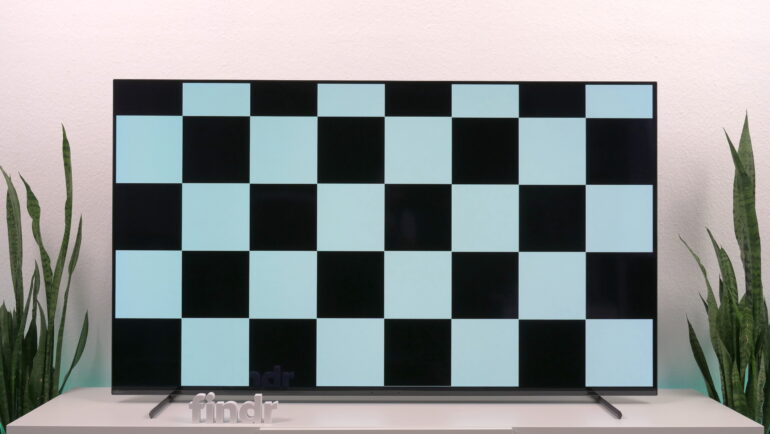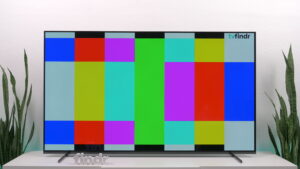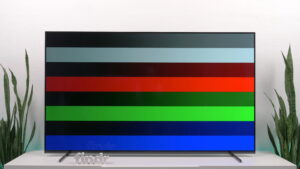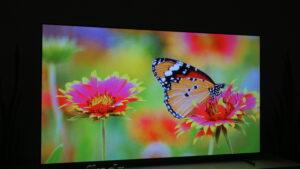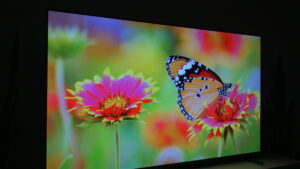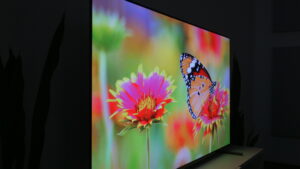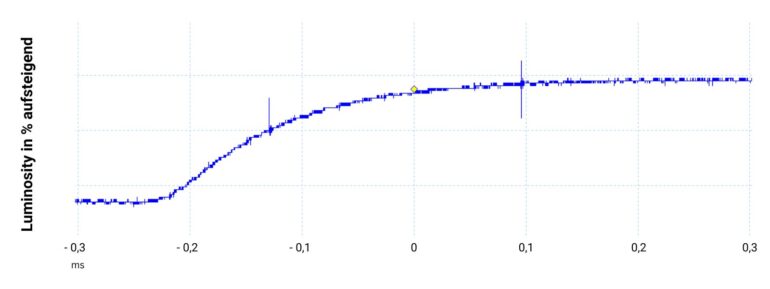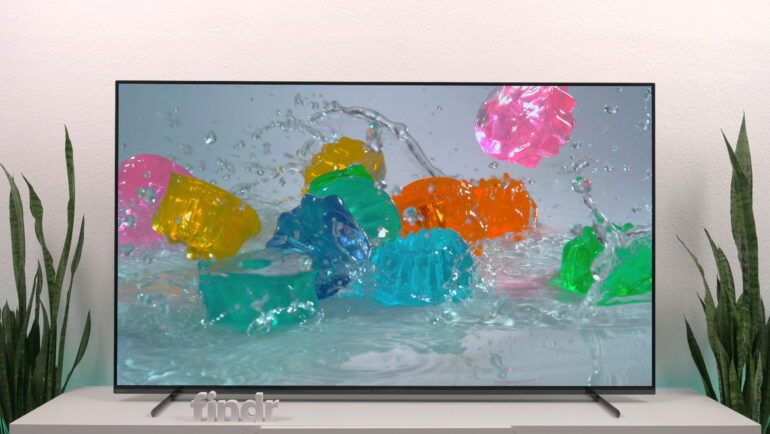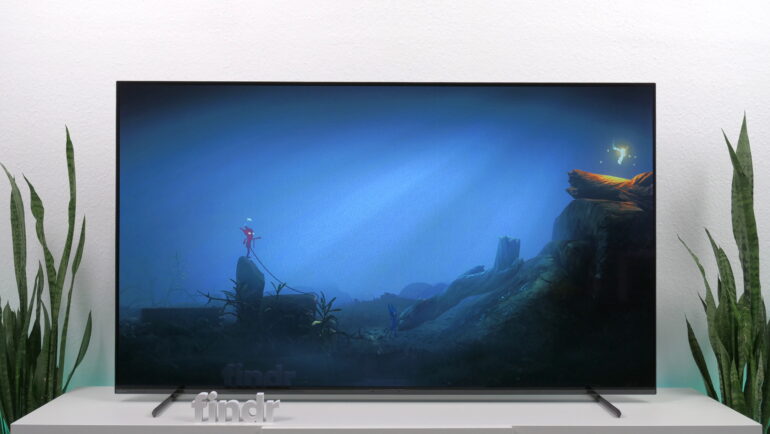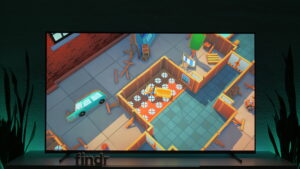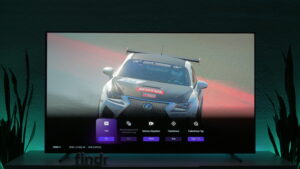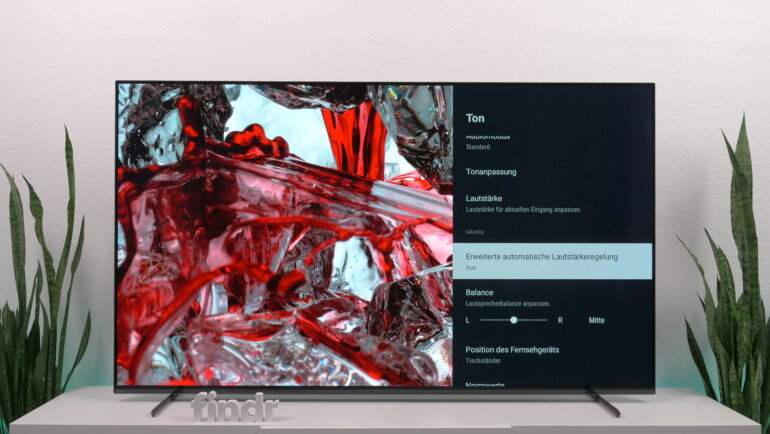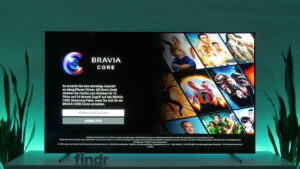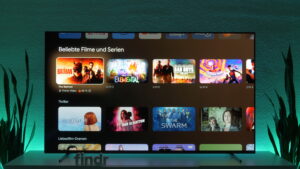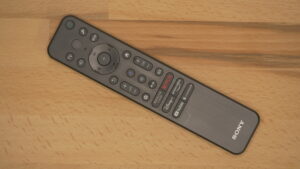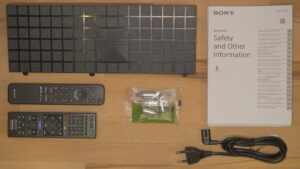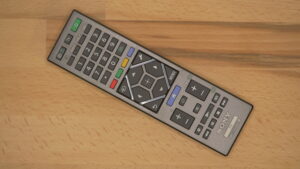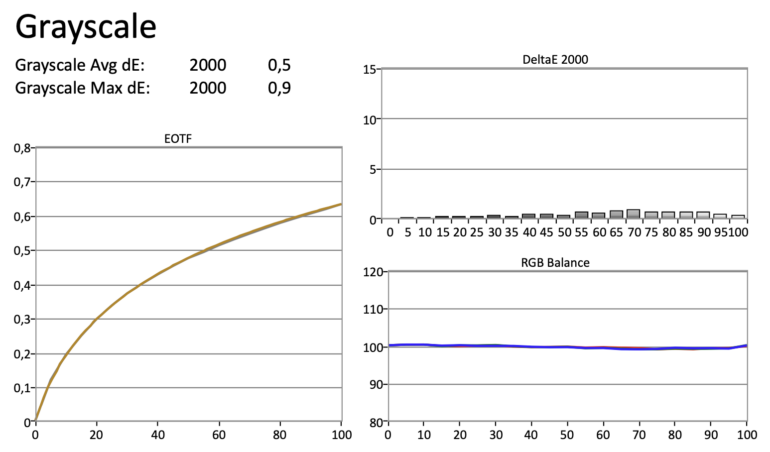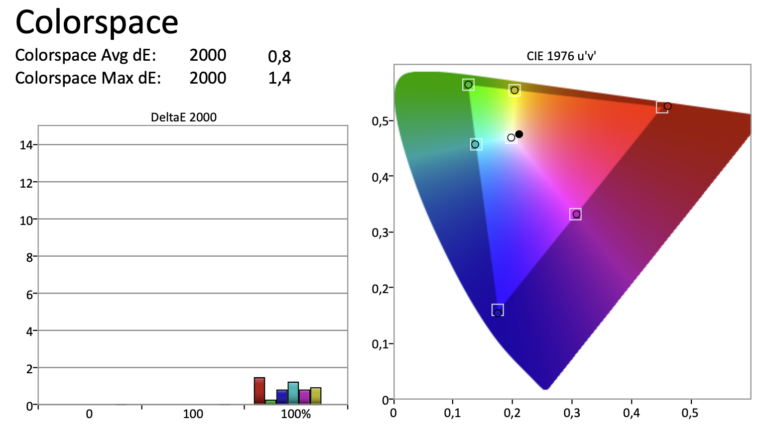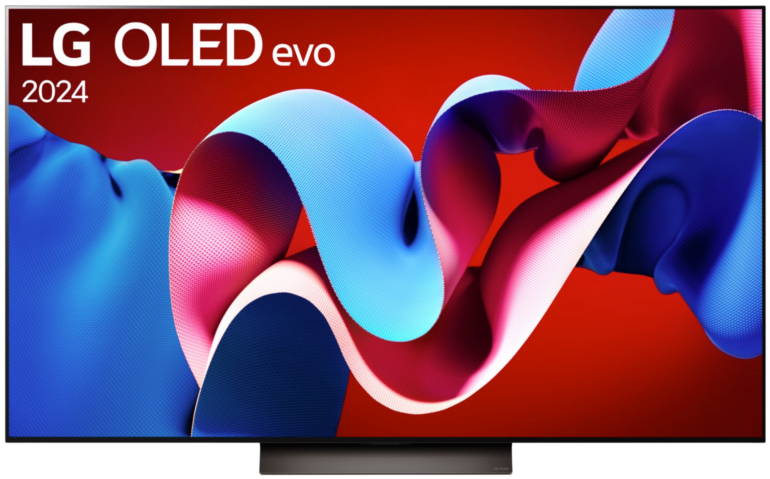Sony A80L Review & Rating

tvfindr Editorial
As a studied technology journalist Tobi likes to write regularly about the colorful world of TV sets & Co. Further interests: Music, cars, gaming, soccer
Sony A80L — Tuned picture quality for your home cinema
If you are considering the purchase of a new TV for your home theater, the Sony A80L should at least be in the first group of potential candidates. Although OLED models by the Japanese company are not exactly among the cheapest TV devices on the market, they can bring out additional quality thanks to their optimised colour performance. Although the 2023 model confirms the performance of its predecessor, it does not offer much more.
Thanks to the various HDR formats, including Dolby Vision and IMAX Enhanced Support, film enthusiasts benefit even more. However, this only applies if the viewing takes place in moderate lighting conditions at the most. The usual luminance deficit compared to a backlight becomes apparent already in daylight. This fact should therefore not be disregarded if the TV is operated outside of a dark environment.
When it comes to gaming, the A80L is not exactly a shining example and has to make concessions in terms of HDMI interfaces and Dolby Vision Gaming, among other things. Nevertheless, there is no real cause for concern here. Other TV devices simply offer a little more in this area. When it comes to sound performance, there is not much more to be gained above normal daily use. A third-party solution via soundbar or home cinema system is definitely advisable. The operating system is not the most user-friendly, but it can be navigated smoothly and quickly. You are also well positioned regarding the diversity of apps here.
- Wide colour gamut
- Screen reacts extremely agilely
- Many audio formats
- Game mode with ALLM
- Exclusive PS5 features
- Smooth OS navigation
- Feet adjustable in height and width
- Peak brightness slightly low
- Brightness control interferes strongly
- Only two HDMI 2.1 ports
- No DV gaming with 4K at 120 hertz
Sony A80L: Potential alternatives for you
If the Sony A80L is a little too expensive for you, but you don’t want to do without an OLED solution, you should take a look at the LG OLED evo C3, which is usually cheaper. Here you get a little more brightness and even better gaming support.
The predecessor A80K is on a similar performance level and therefore also something for true cinema enthusiasts. However, with the same size, you can now buy the 2022 model at a much lower price and thus get a much more attractive price-performance ratio.
A TV with real backlighting can be useful if you have to deal with bright lighting conditions and do not use the device exclusively in the dark. Here we recommend taking a look at the Samsung QN85C. This TV has Mini-LEDs and offers significantly more brightness potential.
Lower-priced predecessor: Sony A80L
More suitable for gaming: LG OLED evo C37
Significantly brighter: Samsung QN85C
Sony A80L: Installation made easy
After we freed the test device from the usual packaging material and carefully sorted the included equipment, our OLED was ready to be mounted onto the two included stands on the tabletop of our test lab.
As with the predecessor, the fixing was done in no time and without any tools. You will hardly be able to do this much faster and less complicated. Even Samsung’s QD series cannot keep up here.
- Good manufacturing quality
- Height and width adjustment of the feet
- Stable stand
- Without a real solution for cable routing
- Not tiltable or swivelable
- Construction depth comparatively high
You have the option of a narrow or wide layout. We decided to use the wider option. Apart from that, you can adjust the height of the substructure in three stages if necessary. This provides considerably more space below to place an extra sound bar, for example, without covering the bottom edge of the screen at the same time.
At this point, however, you cannot do without a screwdriver. On the other hand, the construction cannot be tilted or rotated. Our chosen configuration in the lowest setting offers a sufficiently firm stand and never made an unstable impression during the test. However, as you raise the height of the setup, it becomes more “susceptible” to wobbles.
Design inherited from the predecessor
The fully assembled appearance seems clean at first glance, but reminds us more than strongly of the design used for the predecessor. No wonder, because both models are identical in almost every detail.
Narrow edges and a small trim strip on the bottom round off the appearance nicely. Overall, however, the depth of more than 5 centimetres is again not quite as narrow as that of a comparable competitor.
With the exception of the plastic back, the build quality appears to be of a high standard overall and does not really give any cause for serious complaints due to manufacturing defects or conspicuously large tolerances in the gaps. We only noticed a discreet pinkish tinge, which we did not consider to be negative.
When it comes to wall mounting, you’ll find the usual VESA standard with a hole spacing of 300 by 300 millimetres. Sony provides four matching adapters along with the screen. The cable routing, on the other hand, did not convince us. Although a connection cover is included as part of the package, there are no recesses in the casing or other fixing solutions.
If you operate the TV in the lowest foot position, this fact is not even worth mentioning, since you won’t see the cables out the back anyway due to the small distance to the frame. It is more noticeable if you need additional space and have to route the cables down towards the centre.
The Sony A80L also offers the usual good picture quality
Typically, TV devices are most expensive at market launch. Nevertheless, major differences can also arise within a device class or become apparent in the months after release. The Sony A80L – like actually many Sony TVs – is such a case. The reason for this can be found partly in the fine-tuning with a view to an even more brilliant and more precisely colour-adjusted picture quality by the manufacturer from Japan. But thats also the reason why such devices from the mid-range and upper price segments – along with devices from Panasonic – are often among the favourites of true home cinema enthusiasts. enthusiasts.
- Large colour gamut
- High colour precision
- Great viewing angle
- IMAX Enhanced Display
- Slightly lower peak brightness
- Strong ABL intervention
Sony’s top model for 2023 also follows these footsteps. Based on an OLED.EX panel, the A80L makes a rather discreet leap forward and can generally beat the previous performance of its forerunner in large parts, but sets the benchmark only marginally higher.
Due to the self-luminous pixel structure, this model has the usual high, theoretically infinite contrast and is also able to display an ideal black level. How? Parts of the screen are simply switched off as needed. Unlike in backlit devices, bright neighbouring pixels are not negatively affected.
Sony A80L: Less peak brightness than the competitors
Despite the brightness values being lower than those of competing models, the A80L displays a sufficient peak brightness in HDR mode. Even in comparatively ordinary daylight, however, visibility is reduced. So we can only recommend daytime use to a limited extent.
In bright light conditions and with light sources that could be reflected in the screen, such as window fronts or lamps, we do not recommend it. In fact, the OLED does not really show its full performance until the room is dark. Unfortunately, as with most comparable TVs, the automatic brightness limiter intervenes in large and bright parts of the picture and reduces the luminosity fairly strong.
An advantage of the A80L is the wide HDRHigh Dynamic Range – image/video with more dynamic range (contrast range) colour space. Colours appear vivid and real. The model not only has almost ideal coverage in the DCI-P3 range, but also achieves a thoroughly presentable range in the larger Rec 2020 space.
Regarding the Grey Unifomity, Sony does not reveal any negative surprises either. Spots or noticeable irregularities are practically non-existent on the screen of our test device.
Although – taking the Samsung S90C QD-OLED as an example – we can see that there is still some room for improvement here. The viewing angle is fantastic. So you get a stable image impression, even from the side. Therefore a large room with a wide seating area is not an issue.
As already described in the processing section, the panel has a subtle pink tint, but this does not spoil the viewing experience any further. Blooming is absolutely no problem with the A80L. Over-illumination either.
Rapid response time of the Sony A80L with typical disadvantages
The Sony A80L’s display has a nearly instantaneous response, which we could also confirm via our internal measurement. This effectively minimises motion blur behind objects. Fast scene changes or position changes on the screen during sports broadcasts can thus be captured more clearly.
- Reacts in the blink of an eye
- Smoother playback due to interpolation
- Significantly darker with BFI
- A lot of action creates artefacts
Although this is not unusual for an OLED model, it can still leave the viewer with the impression of residual blur, depending on the frame rate. For content with up to 60 frames per second, you have the option to activate the so-called BFI to counteract this effect. However, since the Sony A80L doesn’t offer top values in terms of brightness, we recommend to really not use this option if you dont really have to. Its disadvantage is the significantly reduced luminance and visible flickering.
Another approach is to activate the motion interpolation function. With this function, the TV calculates matching intermediate frames with a frequency of up to 120 frames on the basis of the existing picture material. This can help content with a low frame rate to be displayed more smoothly.
A disadvantage is the usual soap opera effect and possible artefacts when there is a lot of action, which become noticeable during playback. In order to find the best setting for you, it is worthwhile to test various adjustments more extensively and in the course of different contents.
Gaming ambitions not perfect with the Sony A80L, but good
The high picture quality does not stop at gaming either. Here too, however, we recommend keeping the lighting conditions rather moderate in order to benefit most from the great contrast and ideal black level. Although the input delay in gaming mode is slightly higher than that of the competition, the Sony A80L is suitable for both shorter and longer gaming sessions in a native resolution of up to 4K at 120 hertz due to the quite good specifications overall.
The weak point – as with the predecessor – are once again the connectors. While you can use all four interfaces with full bandwidth based on HDMI 2.1 on comparable TV devices, you are still provided with only two sockets on the back here.
- High image quality
- Responsive
- Game mode
- PS5 exclusive features
- Game Menu
- HDMI 2.1 only available at two ports
- Dolby Vision is not available with 4K@120 Hertz
- No cloud gaming
Features exclusive to PS5 owners
With an external player, receiver and a soundbar, this can be tight with just one console these days, and may force some of you to use a compatible HDMI switch. In addition, the TV does not support a 1440p signal and has a maximum of 60 frames in Dolby Vision Gaming mode on the Xbox Series X|S.
PlayStation 5 owners get Auto Genre Mode with preset picture settings, Auto HDRHigh Dynamic Range – image/video with more dynamic range (contrast range) Tone Mapping and Auto Low Latency Mode for further optimisation of the response behaviour at screen and controller level. On the Xbox, however, you have to activate ALLMAuto Low Latency Mode – Automatically detects connected consoles and keeps input lag as low as possible. manually.
At just under 9 milliseconds, the measured values are slightly below the performance of an A80K. On paper, however, the model does not come close to gaming powerhouses like the LG OLED evo C3 or an S90C QD OLED.
An AMD FreeSync option is not part of the setup. Instead, you get G-Sync compatibility in addition to conventional VRR. An Cloud Gaming option, which is currently known from other TV models, is not yet available on the Sony A80L, and at this point it misses out on useful potential.
PS5 Remote Play is currently only supported with Google TV version 12. For those who are looking for a television as an alternative to a monitor, Sony – as before with the A90K series – does not offer a current solution with a special focus on screen diagonals of less than 50 inches.
Sony A80L with convincing surround sound that lacks boom
Basically, the reproduction coming out of the speakers sounds good at first. Dialogues are played out cleanly by the 3.2-channel system with Acoustic Surface Audio+ and are thus clearly understandable. The simulated surround sound does play really well and can be adjusted to the nature of the room and the seating position. In addition, several preset equalizer options and automatic genre recognition are available.
- Good surround sound impression
- Room and position adjustment
- Many audio codecs available
- Hardly any bass
- Unclear at higher volume
For normal use, the quality is absolutely sufficient. However, if you turn up the volume, the performance quickly reaches its limit. Sound distortions are then unavoidable and noticeably affect our subjective sound impression. This is where restraint is needed in order not to overstrain the sound generators.
If this is not your thing, you should choose an external solution. Then the many supported codecs such as Dolby Atmos or DTS:X can be implemented via the eARC interface with the necessary pressure and an even more precise sound quality. Especially film fans will not be able to avoid this.
With a compatible Sony soundbar, you can use the TV as an additional source via Acoustic Center Sync. The Sony A80L does not offer a headphone input. Our search for a multi-room function was also in vain. However, Bluetooth ensures that you don’t have to forgo connecting a headset if necessary.
Barely any changes from the previous year in the OS of the Sony A80L
When we first navigated through the operating system, we noticed that the rather convoluted structure of previous years has not really changed much in Google TV 11. Although navigation runs smoothly and without long waiting times, in our opinion the OS is almost overloaded with different menus. An equalised solution based on a real central main screen would result in a more user-friendly concept, we think.
- Navigation läuft flüssig
- Fernbedienung in zweifacher Ausführung
- Eingabehilfen wie Bildschirmvorleser
- Sprachsteuerung
- OS mit durchschnittlicher Nutzerfreundlichkeit
Instead, the selection on the remote control’s keypad repeatedly turns out to be a search task until, after some time, we finally manage to find our way around again. Other manufacturers are simply more adept at this. In addition, there are the nowadays almost obligatory advertisements as part of the user interface, which wave at you in many places.
Two types of remote control
Our test unit came with two remote controls. On one hand, the compact design already known from other devices in polished metal look with quick-start buttons and integrated microphone.
On the other hand, an edgy one in a retro look with a dedicated number field and a partially enlarged key area for people with somewhat bigger hands. However, you won’t find any buttons for direct selection. All the important apps are included. If you are missing something, you will most likely find it in the Google Play Store.
Unlike its larger QD brother, a matching Bravia Cam is not part of the equipment. You get additional connectivity via Apple Airplay and the smart home application Apple Homekit. Hard drive recordings via USB are also no obstacle. Input aids such as text magnification or a screen reader are among the functions as well. If required, you can set different home decoration themes and thus adapt the ambience.
Not good in all areas before calibration
In the run-up to the actual calibration, we first send each TV to the obligatory inspection of the actual condition. Of course, we also did this with the Sony A80L. However, our results were rather mixed. In most brightness ranges, the model shows quite clear deviations to the reference with more than 5 error points. Basically, the following picture emerges: as the screen becomes brighter, the error rate increases.
In terms of colour mixing, red and green are almost perfectly aligned. For blue, however, this only applies for the darkest colour areas. Starting at a luminance of 20 per cent, the proportion here is generally too high and immerses the screen in a slight blue tint. This can be seen in particular by the almost 4 error points for the colour cyan. As you can see in the graphic, however, the curve within the so-called EOTF curve is already clean. So there is hardly any potential for correction in this spot.
Significantly more evenly afterwards
With the help of the Calman Ready support, the Sony A80L could be directed through the calibration easily as well as comparatively quickly and rewarded us afterwards with a noticeably more precise overall result. At first, this concerns the above-mentioned deviations in the individual brightness saturations. There has now been a more than noticeable improvement across the entire scale. Grey tones are shown as intended and no longer look out of place.
Regarding the colour balance, blue has found its way into the reference range over the entire brightness gradient and thus ensures a well-balanced mixing ratio. The cyan portion of the overall colour image has also decreased accordingly. Even the minimal error in the middle range of red and green has been corrected. All in all, the colour correction amounts to more than 4 error points and is satisfying for us. As expected, not much has been done to the gamma correction. Only a few minimal adjustments were made here.
Sony A80L Datasheet
55A80L technical specifications
Dimensions
| Screen diagonal | 55 Inch |
|---|---|
| Dimensions without stand (WxHxD) | 1227 x 712 x 53 mm |
| Weight without stand | 17,9 kg |
| Dimensions with stand (WxHxD) | 1227 x 738 x 327 mm |
| Weight with stand | 18,8 kg |
| Footprint (WxD) | 1164 x 327 mm |
| VESA Norm | 300 x 300 mm |
Image properties
| Panel type | OLED Panel |
|---|---|
| Panel Manufacturer | LG Display |
| Colour depth | 10 Bit |
| FRC | |
| Resolution | 4K |
| Contrast ratio | infinitely :1 |
| Color space coverage | 74 % |
| REC 2020 | 31 % |
| Average brightness | 490 Nits |
| Maximum brightness | 690 Nits |
| Backlighting | OLED |
| Local dimming | OLED |
| Dimming Zones | N/A |
| Curved | |
| Improved viewing angle |
Motion Handling
| Response Time | < 1 ms |
|---|---|
| Input Lag | < 17 ms |
| Frequency | 120 Hz |
| VRR |
HDR
| HDR | |
|---|---|
| HDR10 | |
| HLG | |
| HDR10+ | N/A |
| Dolby Vision |
Energy
| Energy consumption standby (W) | 0,5 W |
|---|---|
| Energy consumption SDR | 83 W |
| Energy efficiency clas SDR | G |
| Energy consumption HDR | 97 W |
| Energy efficiency clas HDR | G |
Smart TV
| Operating system | Google TV |
|---|---|
| Bluetooth | |
| WLAN | |
| USB recording PVR | |
| Timeshift | |
| Picture-in-picture | N/A |
| Tuner | Analog (NTSC/PAL/SECAM) DVB-T DVB-T2 DVB-C DVB-S DVB-S2 |
| Twin Tuner |
Audio
| Audio Channels | 3.2 |
|---|---|
| Power (W) | 50 W |
| Dolby Digital | |
| DTS | |
| Dolby Atmos | |
| Integrated soundbar |
Connections
| HDMI 2.0 | 2 |
|---|---|
| HDMI 2.1 | 2 |
| HDMI ARC | |
| USB 2.0 | 2 |
| USB 3.0 | |
| Ethernet RJ45 | 1 |
| 3.5mm jack | 1 |
| Digital optical | 1 |
| Satellite | 2 |
| Antenna | 1 |
| Ci+ 1.4 | 1 |
65A80L technical specifications
Dimensions
| Screen diagonal | 65 Inch |
|---|---|
| Dimensions without stand (WxHxD) | 1448 x 836 x 53 mm |
| Weight without stand | 23,3 kg |
| Dimensions with stand (WxHxD) | 1448 x 862 x 327 mm |
| Weight with stand | 24,2 kg |
| Footprint (WxD) | 1164 x 327 mm |
| VESA Norm | 300 x 300 mm |
Image properties
| Panel type | OLED Panel |
|---|---|
| Panel Manufacturer | LG Display |
| Colour depth | 10 Bit |
| FRC | |
| Resolution | 4K |
| Contrast ratio | infinitely :1 |
| Color space coverage | 74 % |
| REC 2020 | 31 % |
| Average brightness | 490 Nits |
| Maximum brightness | 690 Nits |
| Backlighting | OLED |
| Local dimming | OLED |
| Dimming Zones | N/A |
| Curved | |
| Improved viewing angle |
Motion Handling
| Response Time | < 1 ms |
|---|---|
| Input Lag | < 17 ms |
| Frequency | 120 Hz |
| VRR |
HDR
| HDR | |
|---|---|
| HDR10 | |
| HLG | |
| HDR10+ | N/A |
| Dolby Vision |
Energy
| Energy consumption standby (W) | 0,5 W |
|---|---|
| Energy consumption SDR | 96 W |
| Energy efficiency clas SDR | F |
| Energy consumption HDR | 112 W |
| Energy efficiency clas HDR | G |
Smart TV
| Operating system | Google TV |
|---|---|
| Bluetooth | |
| WLAN | |
| USB recording PVR | |
| Timeshift | |
| Picture-in-picture | N/A |
| Tuner | Analog (NTSC/PAL/SECAM) DVB-T DVB-T2 DVB-C DVB-S DVB-S2 |
| Twin Tuner |
Audio
| Audio Channels | 3.2 |
|---|---|
| Power (W) | 50 W |
| Dolby Digital | |
| DTS | |
| Dolby Atmos | |
| Integrated soundbar |
Connections
| HDMI 2.0 | 2 |
|---|---|
| HDMI 2.1 | 2 |
| HDMI ARC | |
| USB 2.0 | 2 |
| USB 3.0 | |
| Ethernet RJ45 | 1 |
| 3.5mm jack | 1 |
| Digital optical | 1 |
| Satellite | 2 |
| Antenna | 1 |
| Ci+ 1.4 | 1 |
77A80L technical specifications
Dimensions
| Screen diagonal | 77 Inch |
|---|---|
| Dimensions without stand (WxHxD) | 1722 x 998 x 54 mm |
| Weight without stand | 34,8 kg |
| Dimensions with stand (WxHxD) | 1722 x 1027 x 385 mm |
| Weight with stand | 36 kg |
| Footprint (WxD) | 1385 x 385 mm |
| VESA Norm | 300 x 300 mm |
Image properties
| Panel type | OLED Panel |
|---|---|
| Panel Manufacturer | LG Display |
| Colour depth | 10 Bit |
| FRC | |
| Resolution | 4K |
| Contrast ratio | infinitely :1 |
| Color space coverage | 74 % |
| REC 2020 | 31 % |
| Average brightness | 490 Nits |
| Maximum brightness | 690 Nits |
| Backlighting | OLED |
| Local dimming | OLED |
| Dimming Zones | N/A |
| Curved | |
| Improved viewing angle |
Motion Handling
| Response Time | < 1 ms |
|---|---|
| Input Lag | < 17 ms |
| Frequency | 120 Hz |
| VRR |
HDR
| HDR | |
|---|---|
| HDR10 | |
| HLG | |
| HDR10+ | N/A |
| Dolby Vision |
Energy
| Energy consumption standby (W) | 0,5 W |
|---|---|
| Energy consumption SDR | 121 W |
| Energy efficiency clas SDR | E |
| Energy consumption HDR | 142 W |
| Energy efficiency clas HDR | G |
Smart TV
| Operating system | Google TV |
|---|---|
| Bluetooth | |
| WLAN | |
| USB recording PVR | |
| Timeshift | |
| Picture-in-picture | N/A |
| Tuner | Analog (NTSC/PAL/SECAM) DVB-T DVB-T2 DVB-C DVB-S DVB-S2 |
| Twin Tuner |
Audio
| Audio Channels | 3.2 |
|---|---|
| Power (W) | 60 W |
| Dolby Digital | |
| DTS | |
| Dolby Atmos | |
| Integrated soundbar |
Connections
| HDMI 2.0 | 2 |
|---|---|
| HDMI 2.1 | 2 |
| HDMI ARC | |
| USB 2.0 | 2 |
| USB 3.0 | |
| Ethernet RJ45 | 1 |
| 3.5mm jack | 1 |
| Digital optical | 1 |
| Satellite | 2 |
| Antenna | 1 |
| Ci+ 1.4 | 1 |
83A80L technical specifications
Dimensions
| Screen diagonal | 83 Inch |
|---|---|
| Dimensions without stand (WxHxD) | 1850 x 1067 x 53 mm |
| Weight without stand | 42 kg |
| Dimensions with stand (WxHxD) | 1880 x 1072 x 428 mm |
| Weight with stand | 43,5 kg |
| Footprint (WxD) | 1880 x 428 mm |
| VESA Norm | 400 x 400 mm |
Image properties
| Panel type | OLED Panel |
|---|---|
| Panel Manufacturer | LG Display |
| Colour depth | 10 Bit |
| FRC | |
| Resolution | 4K |
| Contrast ratio | infinitely :1 |
| Color space coverage | 74 % |
| REC 2020 | 31 % |
| Average brightness | 490 Nits |
| Maximum brightness | 690 Nits |
| Backlighting | OLED |
| Local dimming | OLED |
| Dimming Zones | N/A |
| Curved | |
| Improved viewing angle |
Motion Handling
| Response Time | < 1 ms |
|---|---|
| Input Lag | < 17 ms |
| Frequency | 120 Hz |
| VRR |
HDR
| HDR | |
|---|---|
| HDR10 | |
| HLG | |
| HDR10+ | N/A |
| Dolby Vision |
Energy
| Energy consumption standby (W) | 0,5 W |
|---|---|
| Energy consumption SDR | 149 W |
| Energy efficiency clas SDR | F |
| Energy consumption HDR | 188 W |
| Energy efficiency clas HDR | G |
Smart TV
| Operating system | Google TV |
|---|---|
| Bluetooth | |
| WLAN | |
| USB recording PVR | |
| Timeshift | |
| Picture-in-picture | N/A |
| Tuner | Analog (NTSC/PAL/SECAM) DVB-T DVB-T2 DVB-C DVB-S DVB-S2 |
| Twin Tuner |
Audio
| Audio Channels | 2.2 |
|---|---|
| Power (W) | 60 W |
| Dolby Digital | |
| DTS | |
| Dolby Atmos | |
| Integrated soundbar |
Connections
| HDMI 2.0 | 2 |
|---|---|
| HDMI 2.1 | 2 |
| HDMI ARC | |
| USB 2.0 | 2 |
| USB 3.0 | |
| Ethernet RJ45 | 1 |
| 3.5mm jack | 1 |
| Digital optical | 1 |
| Satellite | 2 |
| Antenna | 1 |
| Ci+ 1.4 | 1 |
Frequently asked questions on the Sony A80L
What are the main advantages of OLEDs?
TV devices with an OLED panel generally have two fundamental advantages. On one hand, the self-luminous pixels can be switched off completely, as with a lamp. On the other hand, these TVs have a high viewing angle stability. Thus, the viewer still gets a sufficiently good picture quality without colour distortions or much poorer brilliance even when looking at the picture from a relatively oblique angle.
Which panel technology is used here?
The A80L is equipped with a so-called OLED.EX panel, which is basically the second generation of OLED screens. Although Sony TVs are not primarily known for their high brightness values, this allows the TV to turn its display brighter than it was possible for the previous generation.
Which technology is better? OLED or LED?
First of all, this is a question of the lighting conditions on site. TV devices that use OLED technology are only suitable to a limited extent or maybe not at all for bright rooms. Even ordinary daylight can be sufficient to reduce the contrast to a level where details and contours are no longer bright enough for the eye to perceive. This can be the case especially within dark colour ranges.
How does the model compare to its predecessor?
Both devices are almost identical and are therefore basically on a par with each other. However, the A80L is now also available in an 83-inch version, which gives it a slight advantage in terms of size. With the A80K, you won’t find a model above 80 inches at the dealer.
Sony A80L Connections
The 65A80L has 2 HDMI 2.1 inputs and 2 HDMI 2.0 inputs, an HDMI eARC, 2 USB 2.0 ports, a 3.5mm headphone jack, a digital optical TOSLINK output, an analogue video input e.g. for older gaming consoles and a Twin Tuner. and just a Single Tuner.
Sony A80L Dimensions
The Sony A80L is dimensioned without stand as follows (WxHxD):
- 55 Inch: 1227 x 712 x 53 mm
- 65 Inch: 1448 x 836 x 53 mm
- 77 Inch: 1722 x 998 x 54 mm
- 83 Inch: 1850 x 1067 x 53 mm
Sony A80L Wall Mounting
The Sony A80L is compatible with the following wall mounts:
- 55 Inch: 300 x 300 mm
- 65 Inch: 300 x 300 mm
- 77 Inch: 300 x 300 mm
- 83 Inch:
400 x 400 mmFlat Pivotable
